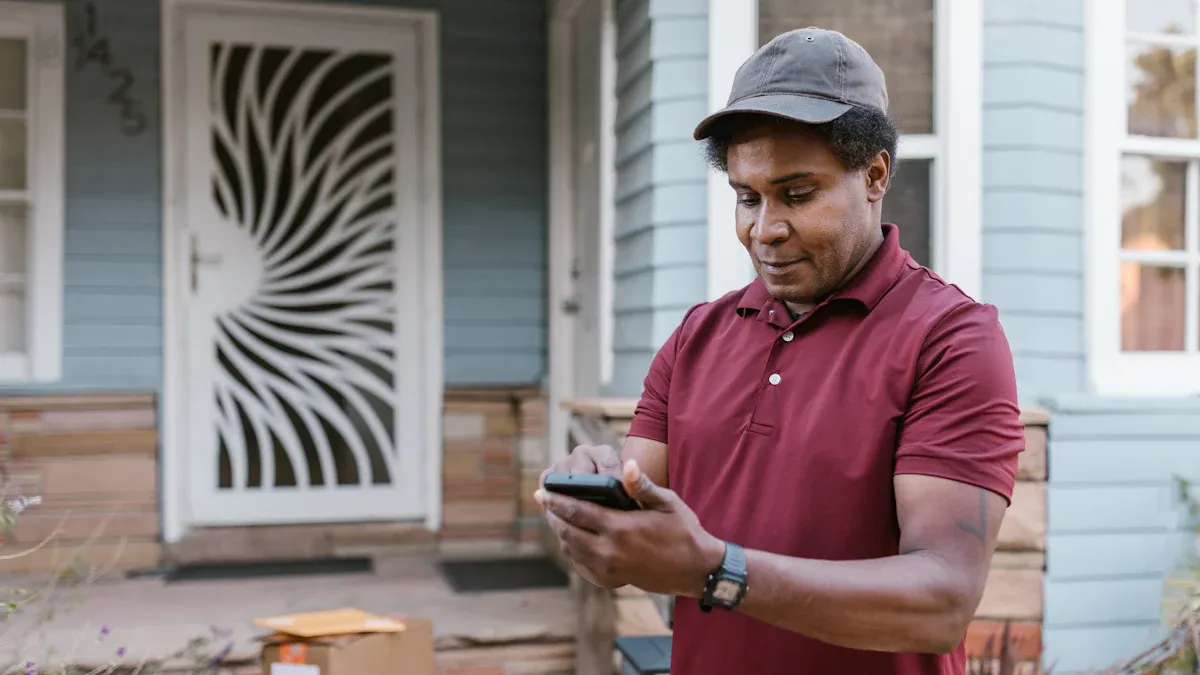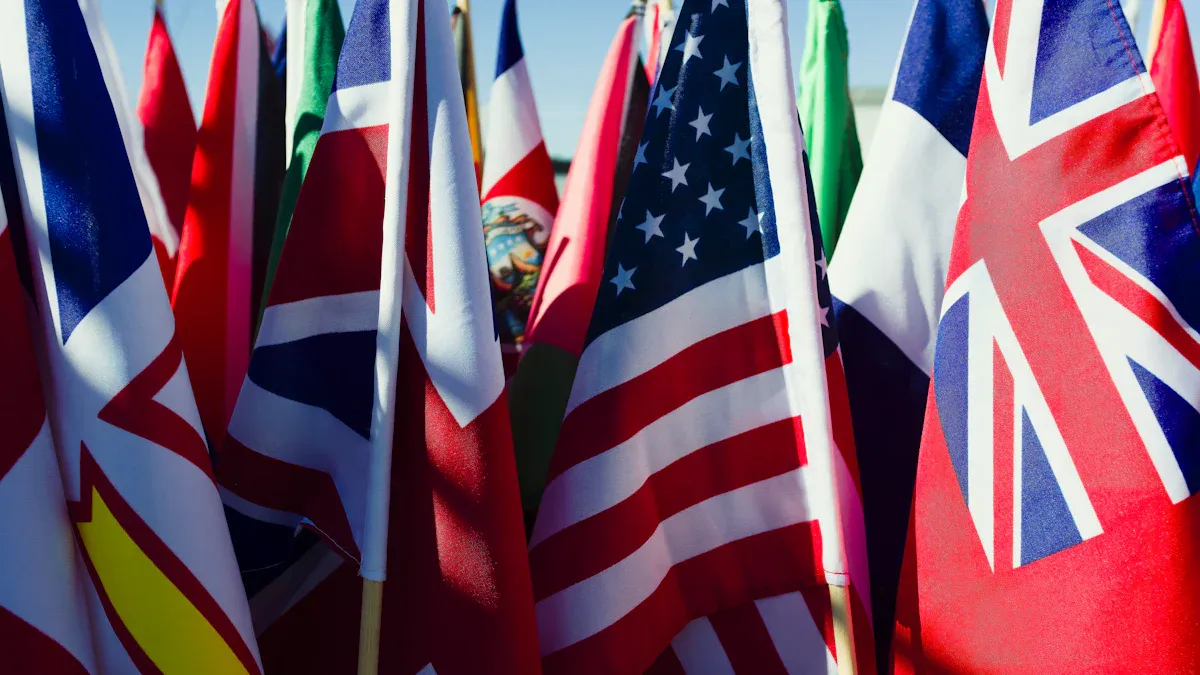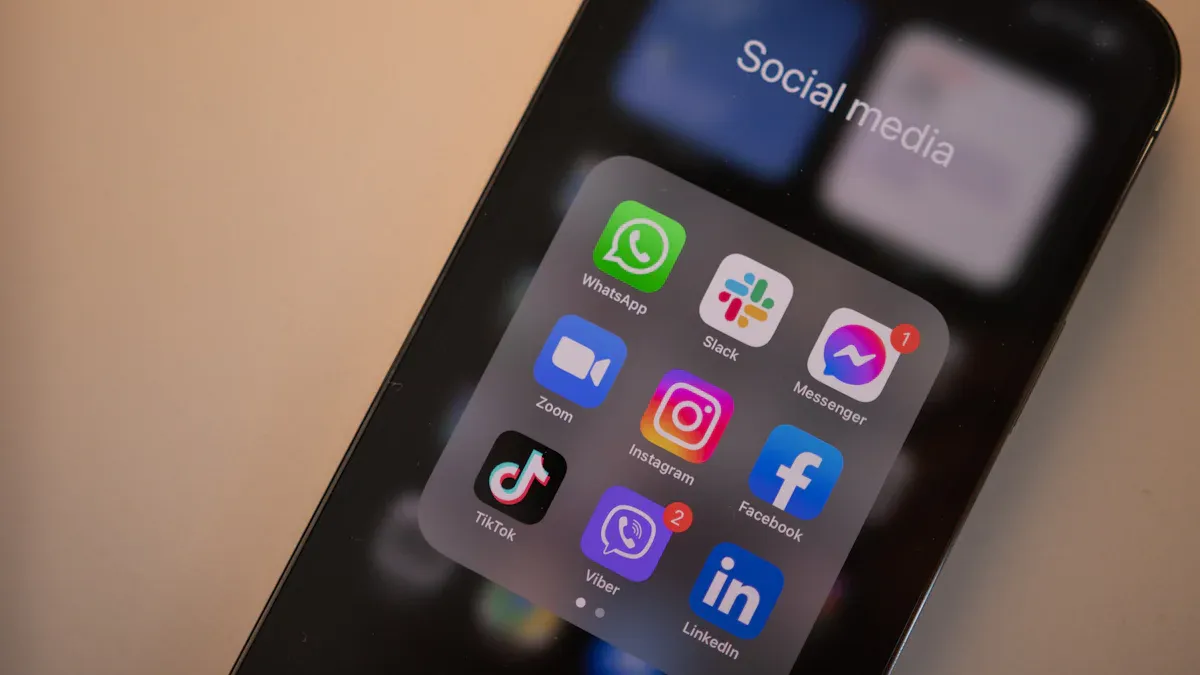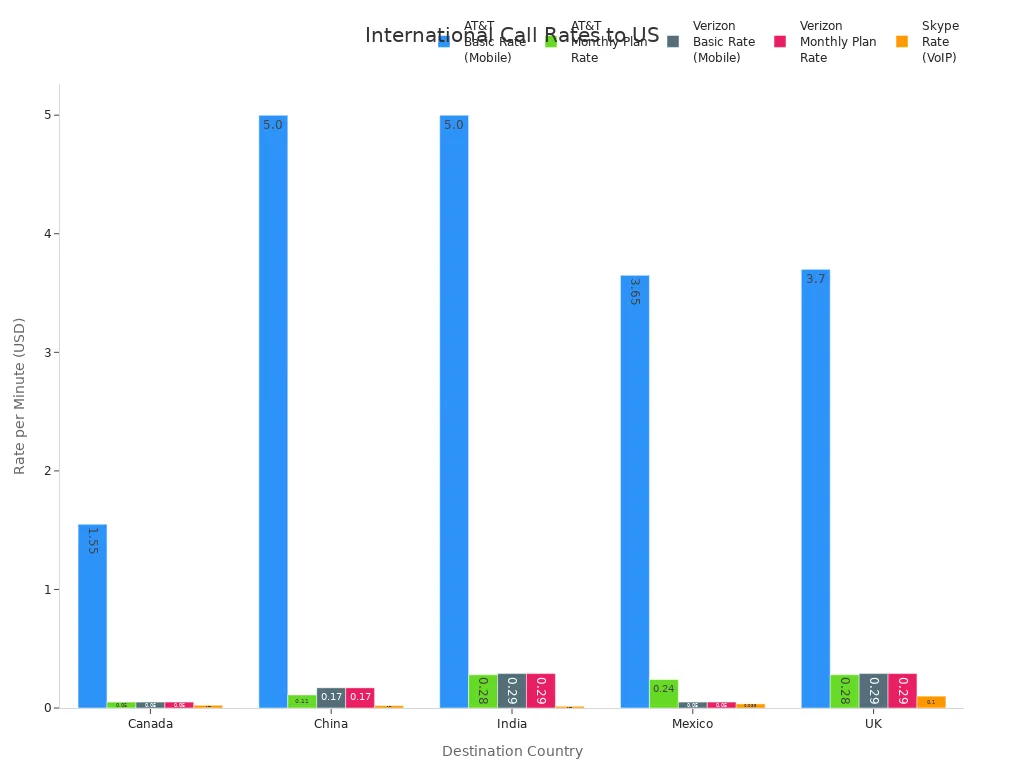- EasyCard
- Trade
- Help
- Announcement
- Academy
- SWIFT Code
- Iban Number
- Referral
- Customer Service
- Blog
- Creator
Everything You Need to Know About the US Calling Code

Image Source: pexels
The country calling code for the United States is +1. You use this country code for the USA to connect calls from outside the country. The International Telecommunication Union assigns this calling code as part of the North American Numbering Plan. When you dial the international country code, your call moves from your local network to the US network. The country code for the USA helps route your call so it reaches the correct destination.
Key Takeaways
- The US country calling code is +1 and is shared with Canada and some Caribbean countries under the North American Numbering Plan.
- To call the US from abroad, dial your country’s exit code (or + on mobile), then +1, followed by the three-digit area code and the seven-digit local number.
- US phone numbers always have ten digits after the country code, with no leading zero; area codes help route calls to specific regions.
- Common dialing mistakes include forgetting the exit code, using the wrong format, or confusing the country code with local numbers.
- If calls fail, check your dialing format, phone settings, and consider using internet calling apps like Skype or Google Voice to save money and improve connection.
United States Country Code

Image Source: unsplash
What Is the Calling Code?
You use the country code +1 when you want to call the United States from another country. This code is not unique to the US. Canada and several Caribbean countries also use the +1 calling code. The reason for this shared code comes from the North American Numbering Plan (NANP). In the mid-20th century, phone use grew quickly. The NANP started in 1947 to organize phone numbers across North America and nearby regions. The plan grouped the United States, Canada, and many Caribbean nations under one system. Each country or region gets a three-digit area code after the +1. This helps you reach the right place, even though many countries share the same country code.
Note: The +1 code makes it easier to call between these countries. You only need to add the correct area code to reach your contact.
The United States country code helps route your call to the right network. When you dial internationally, you always start with the international country code for the USA, which is +1. This code tells the phone system that your call should go to the United States or another NANP country.
Where Is the Country Code for the USA Used?
You use the country code for the USA in many situations. If you call from a landline, you first dial your country’s international exit code. For example, you might dial 011 if you are calling from the United States to another country. If you call from outside the US, you start with your own exit code, then add +1, the area code, and the local number. On mobile phones, you can often use the + sign instead of the exit code.
Here is a simple breakdown of how you use the country code for the USA:
1. Dial the international exit code for your country (or use + on a mobile phone).
2. Enter the United States country code, which is +1.
3. Add the three-digit area code.
4. Finish with the seven-digit local phone number.
You use the +1 calling code for all international calling to the United States, Canada, and some Caribbean countries. This system works for landlines, mobile phones, and even some VoIP services. Some internet-based apps, like WhatsApp or Skype, may not require the country code if you use their contact lists, but you still need it for traditional phone calls.
Common Misconceptions
Many people make mistakes when dialing the country code for the USA. Here are some common errors:
- Forgetting to dial the international access code before the country code. This stops your call from connecting.
- Using ‘001’ or leaving out the ‘+’ sign instead of the correct +1 calling code.
- Entering the wrong phone number format, which causes confusion.
- Thinking that all US phone numbers start with ‘1’. In reality, ‘1’ is only the country code, not part of the local number.
Tip: Always check the full number format before you call. Make sure you include the correct international dialing code and area code.
+1 vs. 011: What’s the Difference?
You might see both +1 and 011 when learning about international dialing. These codes have different jobs:
- 011 is the international exit code you use when calling out of the United States to another country.
- +1 is the country code for the USA, Canada, and some Caribbean countries. You use it after the exit code when calling into these countries.
For example, if you call the United States from China, you dial 00 (China’s exit code), then 1 (the country code for the USA), then the area code and local number. On a mobile phone, you can use +1 instead of the exit code and country code.
| Step | What to Dial | Example |
|---|---|---|
| 1 | Exit code | 00 (from China) or + (on mobile) |
| 2 | Country code | 1 (for the US, Canada, Caribbean) |
| 3 | Area code | 212 (for New York) |
| 4 | Local number | 555-1234 |
The country code system helps phone networks send your call to the right country. The +1 calling code is essential for international dialing to the United States and other NANP countries.
How to Call to the US

Image Source: unsplash
Dialing Steps
You may wonder how to call the USA from another country. The process uses a few simple steps. You need to know the international exit code for your country, the US country code, the area code, and the local number. Here is a clear guide for calling the US:
- Dial your country’s international exit code. For example, use 00 in India and many European countries, 011 in Canada, 010 in Japan, or 0011 in Australia.
- Enter the US country code, which is 1.
- Add the three-digit area code for the city or region you want to reach.
- Finish with the seven-digit local phone number.
Tip: On most mobile phones, you can use the plus (+) sign instead of the exit code. This makes international dialing easier.
Here is a table to help you understand the steps for how to call the USA from different countries:
| Country | Exit Code | Example Call to New York (646-555-2345) |
|---|---|---|
| India | 00 | 00 1 646 5552345 |
| United Kingdom | 00 | 00 1 646 5552345 |
| Canada | 011 | 011 1 646 5552345 |
| Japan | 010 | 010 1 646 5552345 |
| Australia | 0011 | 0011 1 646 5552345 |
| Mobile Phone | + | +1 646 5552345 |
You can see that the dialing code for the US always comes after the exit code. If you use a mobile phone, the plus sign replaces the exit code. This method works for both personal and business calls. Many businesses use virtual numbers or VoIP services to save money and add features, but the dialing steps stay the same.
Phone Number Format
When you learn how to call the USA, you need to know the correct phone number format. The US phone number system uses a fixed pattern. Every US phone number has ten digits after the country code. The format looks like this:
- Enter the US country code: +1
- Dial the three-digit area code
- Enter the seven-digit local phone number
For example, if you want to call a number in New York, you might dial: +1 718 222 2222. The area code (718) tells the system which city or region to reach. The last seven digits are the local number.
Note: Toll-free numbers in the US start with special area codes like 800, 888, or 877. You use the same format when calling these numbers.
The US phone number format is different from many other countries. Some countries use longer or shorter numbers, or they may have a trunk prefix like 0. In the US, you never use a leading zero. The format stays the same for all cities and states.
Here are some common area codes for major US cities:
| City | State | Example Area Codes |
|---|---|---|
| New York City | NY | 212, 646 |
| Los Angeles | CA | 213, 310, 323, 424 |
| Chicago | IL | 312, 773, 872 |
| Washington, DC | DC | 202 |
| San Francisco | CA | 415, 628 |
| Miami | FL | 305, 786 |
| Dallas/Fort Worth | TX | 214, 469, 972 |
| Boston | MA | 617, 857, 508, 781 |
| Seattle | WA | 206 |
| Philadelphia | PA | 215, 267 |
| Detroit | MI | 313 |
You can use these area codes to find the right region when calling the US.
Calling the US from Landline or Mobile
You may ask how to call the USA from a landline or how to call the USA from a cell phone. The steps are similar, but there are some small differences.
When you use a landline, you must dial the full international exit code before the US country code. For example, if you are in the United Kingdom, you dial 00, then 1, then the area code and local number. This is the standard way for how to call the USA from a landline.
If you use a mobile phone, you can often start with the plus (+) sign. The plus sign tells your phone to use the correct exit code for your country. For example, you dial +1, then the area code and local number. This is the easiest way for how to call the USA from a cell phone.
Note: Some countries require you to drop the leading zero from the area code when calling internationally. The US does not use a leading zero, so you do not need to worry about this step.
The cost of calling the US can change based on your provider, the type of phone you use, and your calling plan. Landline rates are often higher without a plan. Mobile rates can be even higher, especially if you do not have an international plan. VoIP services like Skype or RingCentral offer much lower rates. Here is a chart that shows the difference in calling costs from several countries:

You can see that using a monthly plan or a VoIP service can save you a lot of money. For example, calling the US from India with a basic mobile rate can cost up to $5.00 per minute, but with Skype, the rate drops to just a few cents per minute.
When you learn how to call to the US, always check your provider’s rates and consider using a VoIP service if you want to save money. Remember, calling the US from a landline or a cell phone follows the same basic steps, but the dialing code and costs may change.
Tip: If you call the US often, look for international calling plans or apps that offer lower rates.
By following these steps, you can make sure your call to the US goes through without problems. Whether you use a landline or a mobile phone, knowing the right dialing code and phone number format will help you connect quickly.
US Area Codes
Area Code Basics
You see area codes at the start of every us phone number. These three-digit numbers help route calls to the right region in the United States. The North American Numbering Plan (NANP) created the first area codes in 1947. At that time, there were only 86 area codes for the United States and Canada. The plan used a format called NXX, where N is a digit from 2 to 9 and X is any digit from 0 to 9. This system allowed for 800 possible combinations.
Over the years, the number of usa area codes has grown. Today, you find 335 area codes in the United States, including 18 non-geographic codes. This increase happened because more people needed phone numbers for mobile phones, fax machines, and other devices. In the 1990s, the system added area code splits and overlays to keep up with demand. The North American Numbering Plan Administration (NANPA) manages these codes. NANPA assigns area codes based on population, state boundaries, and the need for new numbers.
Note: Some states have many area codes, while others share just one. Special codes like N11 are not area codes but are reserved for services.
Finding the Right Area Code
You may need to find the correct area code for a city or region before dialing an american phone number. Several online tools make this easy. AreaCode.org lets you search by city or state and shows maps of area code boundaries. AllAreaCodes.com offers a searchable database and lists area codes by state. Rozper provides a free lookup tool where you can enter a city, state, or area code to get detailed information, including time zone and nearby codes.
Here is a quick guide to using these resources:
- Go to the website.
- Enter the city or state you want to call.
- Review the area code and coverage details.
- Use the area code when dialing the usa area codes for your call.
These tools help you avoid mistakes and connect your call to the right place.
Troubleshooting and Tips
Common Issues When Calling the US
When you try to call the United States, you may face several problems. Here are some of the most common issues:
- Toll-free numbers like 800 or 866 often need special dialing prefixes in different countries. For example, in Mexico, you must dial 880 instead of 800.
- Some businesses block calls to toll-free numbers based on your location or caller ID settings.
- Your cellular plan may limit calls to certain toll-free numbers, causing calls to drop or block after repeated attempts.
- Collect calls rarely work from cell phones and only matter for landlines.
- US cell phones may not accept Universal International Freephone Numbers (+800).
- Network settings, such as roaming or network selection, can stop your call from connecting.
- Wi-Fi calling and apps like Skype or Google Hangouts can sometimes help you reach US numbers when regular calls fail.
- Many users find that changing network settings on their phone, such as switching from automatic to a specific network, can fix calling problems.
Tip: Always check your phone’s network settings and make sure you use the correct country code when making international calls.
Solutions and Advice
You can solve most calling problems by following these steps:
- Make sure your device is registered with your phone or VoIP provider.
- Turn off SIP ALG in your router settings to avoid call interference.
- Update your phone and any calling apps to the latest version.
- Increase your internet bandwidth if you use VoIP, and close other apps that use the internet.
- Set your router’s Quality of Service (QoS) to give priority to calls.
- Check your call forwarding and Do Not Disturb settings.
- Contact your provider if you still have trouble.
To improve your chances of a successful call, use a local US caller ID if possible. Call during the best time to call the USA, usually between 8:30 AM and 7:30 PM local time. Avoid calling the same number many times in a row. Leave a clear voicemail and wait at least 30 minutes before trying again. Always use the correct country code and your country’s exit code. For example, from the UK, dial 00 + 1 + area code + local number. Ask your provider about rates, as calling US landlines and mobile phones may cost different amounts.
Note: The best time to call the USA depends on the time zone of the person you are calling. Try to avoid early mornings or late evenings.
Free and Alternative Methods
You can save money by using free or low-cost services for calling USA for free. Many people look for the cheapest way to call the US, especially if they need unlimited calling to United States numbers. Here is a table of popular options:
| Provider | Starting Price (USD/month) | Free Calling to US & Canada | Key Features & Notes |
|---|---|---|---|
| Google Voice | Free (with Google Workspace) | Yes | Integrates with Google, good for personal and small business use. |
| OnSIP | Free plan available | Yes | Flexible, entry-level, no loss of features. |
| OpenPhone | $15 | Yes | No hardware needed, shared numbers, easy setup, good for small businesses. |
| RingCentral | $20 (annual plan) | 14-day trial | Voice, video, messaging, scalable, may be complex for solo users. |
| Vonage | $14.97+ | No | Unified communications, video conferencing (paid), some features cost extra. |
| Nextiva | $20 | Upgrade needed | Multichannel, no free trial, extra fees for CRM. |
Free VoIP services let you make voice and video calls over the internet. These services often include messaging, group calls, and work on many devices. They help you avoid high fees and offer flexibility. Many people use VoIP for calling USA for free and keep a regular phone as a backup for emergencies or when the internet is weak.
Note: VoIP apps need a strong internet connection for good call quality. Traditional calls may work better in areas with poor internet.
When you use any international calling method, remember to protect your privacy. Use secure networks, avoid public Wi-Fi, and keep your devices safe from malware. Privacy laws can change based on where you call from and which service you use.
Block Quote: The privacy rights of US persons in international communications are significantly diminished, if not completely eliminated, when those communications have been transmitted to or obtained from non-US persons located outside the United States.
You can call the United States easily by following these steps:
- Find your country’s exit code (like 00 or +).
- Enter the US country code: 1.
- Add the three-digit area code.
- Dial the seven-digit phone number.
Check your number for mistakes, such as wrong codes or extra digits. If you have trouble, try internet calling apps or contact your provider. Save this guide for future calls and share it with others who need help calling the US.
FAQ
What is the US country calling code?
You use +1 as the country calling code for the United States. This code helps you connect calls from outside the US. You must dial it before the area code and local number.
Can I call the US for free?
You can use internet apps like Google Voice or Skype for free or low-cost calls. Some services offer free calls to US numbers. Always check your internet connection for the best quality.
Why do some US numbers start with 800 or 888?
These numbers are toll-free. Businesses use them so you do not pay for the call. You may need special dialing steps from outside the US. Check with your provider for details.
What should I do if my call to the US does not connect?
Check your dialing format. Make sure you use your country’s exit code, then +1, the area code, and the local number. If you still have trouble, contact your phone provider or try a VoIP app.
How do I find the right area code for a US city?
| City | Area Code Example |
|---|---|
| New York | 212, 646 |
| Los Angeles | 213, 310 |
| Chicago | 312, 773 |
You can search online for area codes or use lookup tools like AreaCode.org.
This guide has given you all the tools you need to connect with friends, family, or business contacts in the United States. You’ve learned to navigate the specific codes, formats, and potential pitfalls of international calling. But this knowledge about calling is just the beginning. The real challenge for many global citizens lies in international finance, where sending money across borders can be just as complex and costly as making an international phone call. You need a solution that simplifies cross-border transactions, provides transparent rates, and saves you money. This is where BiyaPay comes in. Our platform provides real-time exchange rate queries and conversions for a wide range of fiat and digital currencies, and our remittance fees are as low as 0.5%.
Whether you’re sending money home, paying an overseas supplier, or managing your global finances, BiyaPay makes the process fast, affordable, and secure. We support same-day delivery to most countries and regions worldwide, so you can connect with your finances just as easily as you connect with a phone call. Don’t let confusing fees and slow transfers hold you back. Open a secure account with BiyaPay in minutes and experience a new level of financial freedom. Register now to simplify your international transactions.
*This article is provided for general information purposes and does not constitute legal, tax or other professional advice from BiyaPay or its subsidiaries and its affiliates, and it is not intended as a substitute for obtaining advice from a financial advisor or any other professional.
We make no representations, warranties or warranties, express or implied, as to the accuracy, completeness or timeliness of the contents of this publication.




Contact Us
Company and Team
BiyaPay Products
Customer Services
is a broker-dealer registered with the U.S. Securities and Exchange Commission (SEC) (No.: 802-127417), member of the Financial Industry Regulatory Authority (FINRA) (CRD: 325027), member of the Securities Investor Protection Corporation (SIPC), and regulated by FINRA and SEC.
registered with the US Financial Crimes Enforcement Network (FinCEN), as a Money Services Business (MSB), registration number: 31000218637349, and regulated by FinCEN.
registered as Financial Service Provider (FSP number: FSP1007221) in New Zealand, and is a member of the Financial Dispute Resolution Scheme, a New Zealand independent dispute resolution service provider.



















